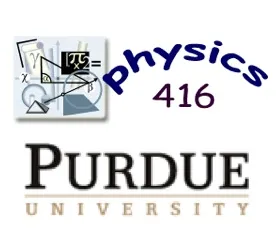
Thermal and Statistical Physics
Thermal and Statistical Physics Purdue University Phys 416
- Update frequency
- every 3 days
- Episodes
- 27
- Years Active
- 2005

Final Review 2
This is a final review for the last 1/4 of the course. This is a very short lecture, because we had a field trip to go see the prestigious Bagwell Lecture given by Purdue's very own Prof. Albert Over…
Mon 12 Dec 2005

Final Review 1
This is a final review for the first 3/4 of the course. Lecture Audio
Mon 05 Dec 2005

Lecture 24: Fluctuation-Dissipation Theorem
We finish two more examples of the Fluctuation-Dissipation Theorem. This is a theorem that pops up everywhere! It means that the very same microscopic processes responsible for establishing thermal e…
Thu 01 Dec 2005

Lecture23: Brownian Motion and Diffusion
Brownian motion was discovered by a botanist named Brown, when he looked at water under a microscope, and observed pollen grains "jiggling" about in it. Einstein eventually explained it as due to the…
Wed 30 Nov 2005

Lecture 22: Nucleation in First Order (Abrupt) Phase Transitions
Supercooling Demonstration (thanks to special guest Prof. Ken Ritchie): Put filtered water in a plastic bottle in your freezer for, say, 4 hours. Now, carefully remove it from the freezer, and shake …
Wed 16 Nov 2005

Lecture 21: Alloys, Mixing, and Phase Separation
Oil and water -- they don't mix. Or do they? Due to the entropy of mixing, any tiny amount of impurity is highly favored entropically. This means that in general, you can get a small amount of a subs…
Tue 15 Nov 2005

Lecture 20: Landau Theory of Phase Transitions; Oil, Water, and Alloys
Now that we know what order parameters are (see last lecture), we'll use the order parameter of a phase to construct the Landau free energy. The Landau free energy depends on the order parameter, and…
Thu 10 Nov 2005

Lecture 19: Symmetries, Order Parameters, and the Failure of Reductionism
We finish the van der Waals equation of state, and use it to illustrate the liquid-gas phase transition. It turns out that at low pressure, the van der Waals equation of state has a wiggle where (dp/…
Tue 08 Nov 2005

Lecture 18: Van Der Waals and Geckos
We derive the shape of the phase boundary for solid to gas transitions (sublimation), examples being dry ice (CO2) or ice at low pressure. We derive the van der Waals equation of state, which is an i…
Wed 02 Nov 2005

Lecture 17: Introduction to Phase Transitions
We finish discussing chemical reactions, including how fast they progress, and what a catalyst can do for you. Then we begin a new topic: phases of matter and phase transitions between them. You've h…
Mon 31 Oct 2005

Lecture 16: Gibbs Free Energy and Chemical Reactions
We define the Gibbs Free Energy, which is the right energy function to use when you can control temperature, pressure, and particle number. This means chemists like it, because chemical reactions in …
Wed 26 Oct 2005

Lecture 15: Refrigerators and Path Dependence of Work
How refrigerators work. Why you can't cool your apartment by leaving the refrigerator door open. How heat and work depend on which path is taken. How to do completely meaningless work, the kind that'…
Mon 24 Oct 2005

Midterm Review
We're having a midterm exam Wednesday, and today is a review of everything in chapters 1-7 in the text, Kittel and Kroemer's Thermal Physics. Topics include: Fundamental assumption of statistical mec…
Mon 17 Oct 2005

Lecture 14: Engines
Storytime with Thursday Next (Jasper Fforde), and her Uncle Mycroft's entropy-detecting entroposcope. Why are large-scale systems capable of producing irreversible processes (like glass breaking, or …
Thu 13 Oct 2005

Lecture 13: Bose Condensates
More about Bose condensates. They're really weird -- at the lowest temperature, all bosons flock to the lowest available state, producing a "Bose condensate". Due to quantum mechanics, this is a rema…
Wed 05 Oct 2005

Lecture 12: Reversible and Irreversible Expansions
Now that we've derived absolutely everything about the ideal gas from scratch, it's time to do something useful with it! We'd like to eventually learn how to use this stuff to build engines and refri…
Mon 03 Oct 2005

Lecture 11: Bose Gas and Ideal Gas
Review of Fermions and Bosons. Review of Fermi Gas. All about the Bose gas, and its ditsrubution function. In the classical limit, the Fermi-Dirac distribution function and the Bose-Einstein distribu…
Wed 28 Sep 2005

Lecture 10: Fermi-Dirac Distribution Function
Why no two pieces of matter may occupy the same space at the same time. Fermions are antisocial; bosons are social. Bosonic examples: lasers and superfluid helium. All about Fermions. Fermions obey t…
Mon 26 Sep 2005

Lecture 9: Gibbs Factor and Gibbs Sum
When the system and reservoir can trade particles, you can't use the Boltzmann factor and the partition function anymore. Instead, use the Gibbs factor, and the grand partition function (or Gibbs sum…
Wed 21 Sep 2005

Lecture 8: Chemical Potential
Introducing a new thermodynamically conjugate pair of variables: number of particles and chemical potential. Internal and external chemical potential. Voltmeters measure the total chemical potential.…
Tue 20 Sep 2005
Disclaimer: The podcast and artwork embedded on this page are the property of Prof. Carlson ([email protected]). This content is not affiliated with or endorsed by eachpod.com.